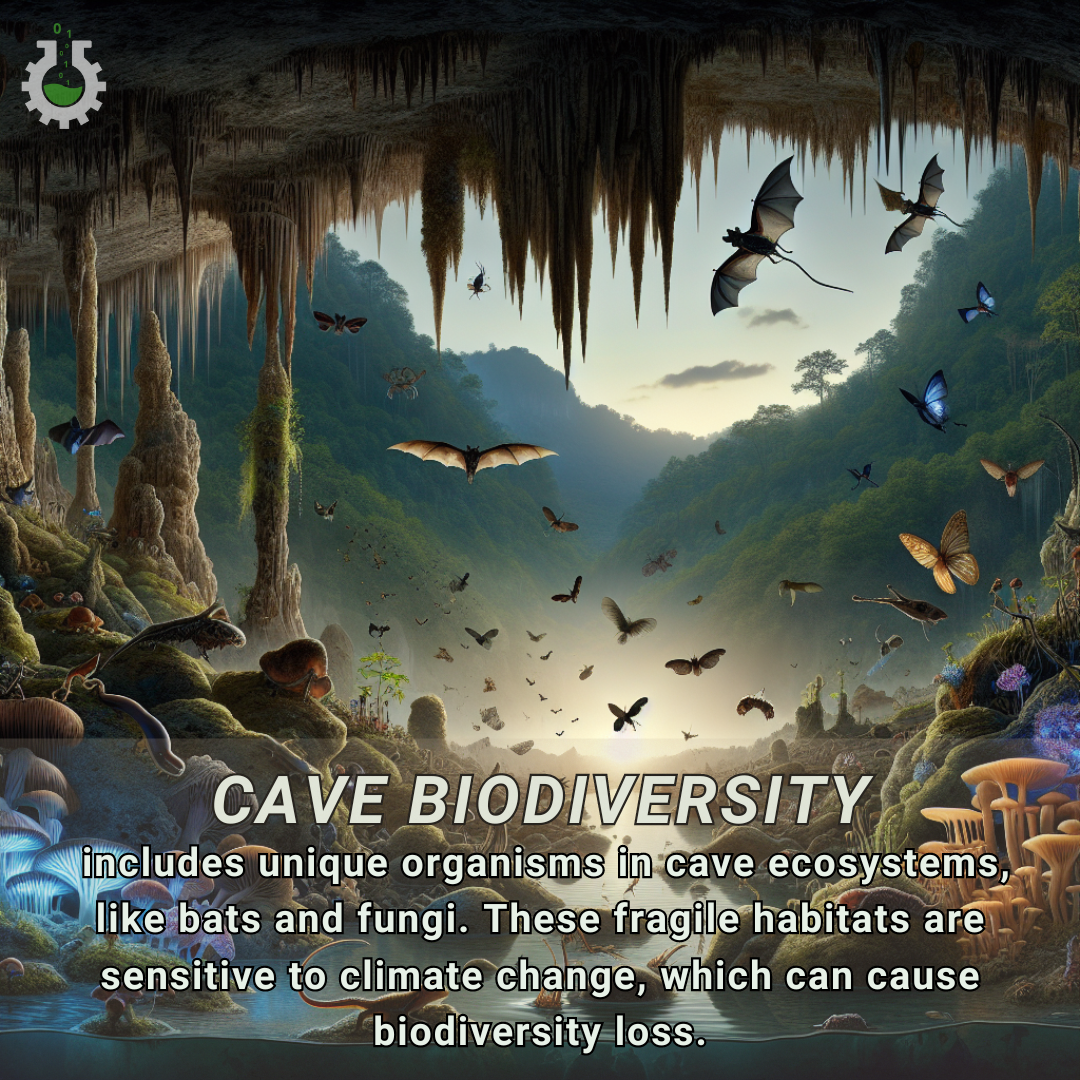
Start thinking more like an analyst.
Learn data science, natural language processing, and big data analysis essentials at your own pace.
Climate Change Poster Collection of the Week – Cave Biodiversity
This week’s Climate Change Poster Collection focuses on Cave Biodiversity. Cave ecosystems, with their unique and often fragile biodiversity, are some of the most intriguing yet overlooked natural habitats on Earth. These subterranean worlds, hidden away from the hustle and bustle of surface life, harbor a plethora of specialized organisms that have adapted to the stable, dark, and nutrient-scarce conditions over millennia. From blind fish and albino insects to delicate fungi and bacteria that thrive in the absence of sunlight, the biodiversity within caves is both remarkable and highly specialized. However, this delicate balance is increasingly under threat from the pervasive impacts of climate change.
As surface temperatures rise and precipitation patterns shift, the microclimates within caves are also affected, leading to changes in temperature and humidity that can be detrimental to cave-dwelling species. These organisms, which have evolved to thrive in stable conditions, often lack the resilience to adapt quickly to such changes, making them particularly vulnerable. For example, many cave species have specific temperature and humidity ranges within which they can survive. Even slight deviations from these ranges can be fatal, leading to declines in population and, in some cases, extinction. Moreover, the interconnectedness of cave ecosystems means that the loss of one species can have cascading effects on others, disrupting the delicate balance that has been maintained for centuries.
Furthermore, altered rainfall patterns can disrupt the hydrological systems that many cave ecosystems depend on. Caves often rely on a consistent flow of water from the surface, which brings in essential nutrients and supports both aquatic and terrestrial species. Changes in precipitation can lead to reduced water flow, affecting the availability of these nutrients and potentially leading to the desiccation of cave habitats. On the other hand, increased rainfall and flooding can introduce pollutants and sediments into caves, further stressing the resident organisms. The nutrient and carbon cycles within caves, which are intricately linked to surface conditions, are also at risk of being disrupted. For instance, changes in vegetation and soil composition on the surface can alter the types and amounts of organic matter that enter caves, affecting the food web and nutrient dynamics within these ecosystems.
Additionally, human activities such as tourism and mining, which are often exacerbated by climate change, add another layer of stress to these already vulnerable habitats. Tourism can introduce pollutants, disturb wildlife, and lead to physical damage to cave structures. Mining, on the other hand, can lead to habitat destruction and contamination of water sources. The combined effects of climate change and human activities can create a perfect storm of challenges for cave ecosystems, making it even more difficult for these fragile environments to recover and adapt.
Understanding the connection between climate change and cave biodiversity is crucial for developing conservation strategies that protect these hidden worlds and the unique life forms they support. Researchers are increasingly recognizing the importance of studying subterranean ecosystems to gain insights into the broader impacts of climate change on biodiversity. By monitoring changes in cave environments and the responses of cave-dwelling species, scientists can develop more effective conservation measures and mitigate the impacts of climate change on these fragile ecosystems.
As we continue to explore and understand the full scope of climate impacts, it is essential to include these subterranean ecosystems in the conversation, ensuring that their silent, dark corners are not forgotten in the fight against climate change. The preservation of cave biodiversity is not only important for the species that inhabit these environments but also for the broader ecological and geological processes that they support. By protecting cave ecosystems, we can help maintain the intricate web of life that exists both above and below the surface, ensuring the resilience and health of our planet for future generations.
Discover an inspiring collection of climate change poster.
Unveiling OpenAI’s Project Strawberry and Orion Models
OpenAI, a leading artificial intelligence lab, is currently developing two advanced AI models, Strawberry and Orion, with the goal of refining AI reasoning, problem-solving, and language processing abilities. These models are expected to take a giant leap forward in terms of AI’s capabilities, opening up new possibilities in a wide range of applications.
Project Strawberry, which was previously known as Q-Star, is anticipated to bring a significant enhancement to the logical analysis capabilities of AI. This model is designed to solve intricate mathematical problems, a task that currently poses a significant challenge for AI systems. The goal of Strawberry is to take AI’s problem-solving abilities to an entirely new level, which could have wide-reaching implications in fields as diverse as cryptography, logistics, and scientific research.
Meanwhile, Orion is set to become OpenAI’s upcoming flagship language model. As the successor to GPT-4, Orion is aimed at offering superior language understanding and generation. This model is being designed to process multimodal inputs, a significant advancement over its predecessor. This means that Orion will be able to process not just text, but also images and videos, making it a much more versatile and powerful tool.
The potential strategic significance of Strawberry and Orion has not been lost on U.S. national security officials, who have shown an interest in these developments. The applications for these advanced models in areas such as intelligence analysis and cyber-security are substantial, and this has understandably caught the attention of those tasked with safeguarding national security.
As AI models become more advanced, they will not only be tools that we use but also collaborators that can help us solve complex problems and generate new ideas.
Adding to the anticipation, OpenAI Japan’s upcoming AI model, known as “GPT Next”, is expected to launch in 2024. GPT Next is being touted as a model that is 100 times more powerful than GPT-4, suggesting a major leap forward in AI capabilities. There are speculations that Orion could be the model succeeding GPT-4 and might be known as “GPT Next”. If these predictions hold true, the AI landscape could see a significant shift in the coming years.
The ongoing developments at OpenAI indicate that the future of AI is bright and holds immense potential. As advanced models like Strawberry, Orion, and possibly “GPT Next” come online, we can expect to see major advancements in AI’s capabilities and its role in our lives.
Connect with our expert to explore the capabilities of our latest addition, AI4Mind Chatbot. It’s transforming the social media landscape, creating fresh possibilities for businesses to engage in real-time, meaningful conversations with their audience
The ‘Rising Waters’ Project on Coastal Erosion in North Carolina
The ‘Rising Waters’ reporting project, generously funded by the Fourth Estate Fund, has been shedding light on the crucial issue of coastal erosion in North Carolina. Focusing specifically on beachfront houses at risk due to climate change, the project delves into the problem of not just storm-related flooding, but also the often overlooked high-tide flooding on clear days. This issue is increasingly becoming a pressing matter, with the finger of blame pointed squarely at climate change.
The project sought the expertise of veteran climate reporter, David Boraks, whose interview brought to light the significant impact of climate change on the Carolina Coast and the Cape Fear region. Boraks’ insights added depth to the understanding of the escalating situation.
In an attempt to address the crisis, a report was released suggesting a number of potential solutions to prevent coastal homes from collapsing into the ocean. Among these solutions was the idea of a state-funded program and the identification of new sources of funding.
The urgency of these measures is underscored by the fact that home collapses continue along the North Carolina coast, with a shocking seven collapses recorded in the last four years alone. This alarming trend is attributed to the relentless erosion and rising water levels caused by climate change.
Lending his voice to the discussion, Professor Tony Rodriguez from the University of North Carolina stated that the problems are only accelerating due to our warming climate. He pointed out that the rising temperatures are causing sea levels to rise and are fueling stronger, more destructive storms.
In response to the growing crisis, a state and federal task force has been assembled to study the threatened beachfront structures. The task force is set to release a report outlining a range of potential solutions. These may include financial assistance for property owners, changes in regulations and alterations to insurance rules.
Meanwhile, the Outer Banks’ National Park Service has taken a proactive approach towards the issue. It has launched a pilot program to buy back some of the homes at risk from climate change. This voluntary scheme is a measure they hope to expand in the future, offering a glimmer of hope amidst the rising waters.
Overall, the ‘Rising Waters’ project offers a disturbing glimpse into the harsh realities of climate change. However, it also highlights the efforts being made to combat the crisis and offers hope for more effective solutions in the future.
Science4Data is committed to cut through greenwashing and measure real impact. Join the journey to a sustainable future. Your actions matter.
AI in the Sky – Reducing Contrail Formation by 54% for Sustainable Air Travel
Innovation and technology merge in a pioneering program that has successfully reduced contrail formation by 54% using artificial intelligence (AI) and predictive mapping. This groundbreaking initiative showcases the potential for AI to significantly mitigate the environmental impact of air travel.
The innovative program leveraged a combination of extensive datasets, including satellite imagery, weather, and flight path data. Using this information, the program developed contrail forecast maps that were used to guide flight paths. The approach was effective in significantly reducing contrail formation, a major contributor to global warming.
The study behind this success was a collaborative effort involving American Airlines, Google Research, and Breakthrough Energy. The initiative rerouted 70 flights based on AI predictions, leading to a marked decrease in contrail formation. The result is encouraging and indicates that rerouting even a small percentage of flights could prevent the majority of contrail warming. This offers a scalable and cost-effective solution for the aviation industry, which is continually seeking ways to reduce its environmental impact.
American Airlines played a crucial role in this pilot program, utilizing AI and predictive mapping to achieve a 54% reduction rate in contrail formation. The program involved pinpointing areas that were likely to produce contrails and providing pilots with accurate information to avoid these zones. This proactive approach was instrumental in the significant reduction of contrail formation.
Despite these promising outcomes, challenges still exist. Refining the science of contrail warming impact, improving forecast models, and balancing contrail avoidance with increased fuel consumption all pose significant hurdles. However, these challenges are not insurmountable and can be overcome with further research and refinement of the program.
In light of the promising results, American Airlines has called for continued research and cooperation from fellow airlines and air traffic control authorities. They believe that with large-scale implementation, the aviation industry can fully harness the potential of this climate intervention. This study serves as a beacon of hope for the future of sustainable air travel, demonstrating how innovation can lead to meaningful change. The initiative underscores the potential of AI in the fight against climate change, offering a glimpse into a future where technology and environmental stewardship go hand in hand.
Science4Data is committed to cut through greenwashing and measure real impact. Join the journey to a sustainable future. Your actions matter.
Magic Secures $320 Million in Funding, Partners with Google Cloud in AI Advancements
Magic, a leading company in the AI industry, has recently secured an impressive $320 million in its latest funding round. This brings the company’s total funding to an impressive $465 million, solidifying its position as a key player in the AI market.
One of Magic’s most significant recent developments is its partnership with Google Cloud to construct two AI supercomputers. This partnership highlights Magic’s dedication to advancing AI research and development, showcasing their commitment to pushing boundaries in the industry.
Magic’s focus on code generation and software development automation has attracted investments from industry leaders such as former Google CEO Eric Schmidt, Jane Street, Sequoia, and Atlassian. This support from key players in the tech industry further underscores Magic’s position as a powerhouse in the AI field.
The company’s innovative Long-Term Memory (LTM) models are another example of Magic’s cutting-edge technology. These models can reason on up to 100M tokens of context during inference, demonstrating Magic’s commitment to pushing the boundaries of AI capabilities.
Magic’s recent progress includes training the LTM-2-mini model with 100M token context and developing a custom in-context GUI framework for tasks like code synthesis. These advancements showcase Magic’s dedication to improving AI capabilities and pushing the boundaries of what is possible in the field.
Amin Vahdat, VP and GM of ML, Services, and Cloud AI at Google Cloud, has praised Magic’s partnership and highlighted its potential to drive advancements in AI technology. By partnering with Google Cloud to build supercomputers powered by NVIDIA GPUs, Magic has secured new funding to accelerate its AI research and development efforts.
Furthermore, Magic’s commitment to improving AI model performance is evident in their work on evaluating long context models like Needle In A Haystack. By recognizing the unique nature of the “needle” and utilizing methods like HashHop for more accurate results, Magic continues to demonstrate their dedication to pushing the boundaries of AI technology.
Overall, Magic’s recent developments and partnerships highlight the company’s position as a leader in the AI industry. With significant funding, innovative technology, and key partnerships, Magic is well-positioned to continue driving advancements in AI research and development.
GameNGen: Google’s Revolutionary AI-Driven Game Engine
Google is making significant strides in the global gaming industry, particularly with its AI-driven game engine, GameNGen. This technology is capable of generating real-time gameplay for the classic game, Doom, completely bypassing the need for a traditional game engine. This remarkable breakthrough stands out as it can produce playable gameplay at 20 frames per second on a single chip. This advancement marks a notable stride forward in AI technology.
The shift to AI-driven game engines such as Google’s GameNGen could potentially revolutionize the $200 billion global gaming industry. By significantly reducing development time and costs, this technology could open up possibilities for the creation of new game genres.
There’s more to GameNGen than meets the eye. The potential uses of this technology extend beyond the realm of gaming. It could potentially impact industries like virtual reality, autonomous vehicles, and smart cities where real-time simulations are crucial.
However, despite these impressive advances, there are still challenges that persist. One of the primary issues includes the need for more computational power for graphically intense games. Moreover, there is also the complexity of developing a versatile AI game engine that is capable of running multiple games.
GameNGen, powered by a neural model, can simulate the classic game DOOM in real-time with high quality, producing over 20 frames per second on a single TPU. The training process of GameNGen involves two phases: initially, an RL-agent is trained to play the game and record the sessions. Following this, a diffusion model is trained to generate the next frame based on the sequence of past frames and actions.
To maintain visual stability over long periods, Gaussian noise is added to encoded frames during the training of a small diffusion model, Stable Diffusion v1.4. This model is conditioned on a sequence of previous actions and observations. This unique approach contributes to the robustness and efficiency of the GameNGen engine.
Google’s GameNGen stands as an impressive development in the gaming industry and beyond. While it still has hurdles to overcome, the potential for this AI-driven game engine is immense and its impact could be far-reaching.








